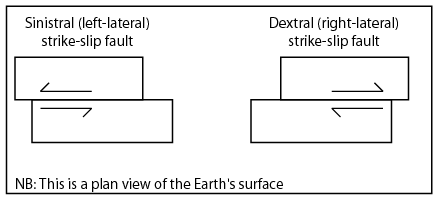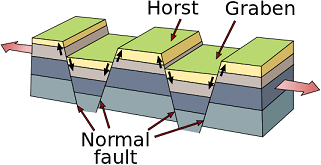Geological faults
The faults are brittle deformation that occur when rocks can not absorb the stresses to which they are subjected. The stresses can be compressive, strain or shear. Materials break apart and the resulting fragments move relative to each other. If there were no displacement, we would speak of joints.
Geometric elements of the faults
In order to classify the faults and understand how they have been formed, it is necessary to define the main elements of the faults:
- Fault blocks or lips. They are each of the two pieces of rock that are separated by the fault plane.
- If the fault plane is not vertical, a distinction is made:
- Upper block: Block that is above the fault plane.
- Lower block: Block is below the fault plane.
- According to the relative movement of the blocks:
- Raised block.
- Sunken block.
- If the fault plane is not vertical, a distinction is made:
- Fault plane. It is the fault plane along which the blocks that separate in the fault move. It can be vertical, horizontal or inclined. The plane can be determined, as we saw when talking about the axial plane of the fold, with the direction and the dip. Due to the friction between the blocks, the fault planes can be polished giving rise to the fault mirrors. Fault striations, rectilinear marks that indicate the direction of movement of the blocks, may also appear on the fault plane.
- Skip jump. It is the distance that one block has moved with respect to the other. It can be measured both laterally, horizontally or vertically. The net jump would indicate the sum of the three previous measurements, and would be indicated by the fault striations.
Interactive activity: Place each element of the fault in its corresponding place.

